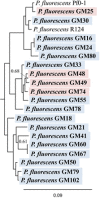Metabolic functions of Pseudomonas fluorescens strains from Populus deltoides depend on rhizosphere or endosphere isolation compartment
- PMID: 26528266
- PMCID: PMC4604316
- DOI: 10.3389/fmicb.2015.01118
Metabolic functions of Pseudomonas fluorescens strains from Populus deltoides depend on rhizosphere or endosphere isolation compartment
Abstract
The bacterial microbiota of plants is diverse, with 1000s of operational taxonomic units (OTUs) associated with any individual plant. In this work, we used phenotypic analysis, comparative genomics, and metabolic models to investigate the differences between 19 sequenced Pseudomonas fluorescens strains. These isolates represent a single OTU and were collected from the rhizosphere and endosphere of Populus deltoides. While no traits were exclusive to either endosphere or rhizosphere P. fluorescens isolates, multiple pathways relevant for plant-bacterial interactions are enriched in endosphere isolate genomes. Further, growth phenotypes such as phosphate solubilization, protease activity, denitrification and root growth promotion are biased toward endosphere isolates. Endosphere isolates have significantly more metabolic pathways for plant signaling compounds and an increased metabolic range that includes utilization of energy rich nucleotides and sugars, consistent with endosphere colonization. Rhizosphere P. fluorescens have fewer pathways representative of plant-bacterial interactions but show metabolic bias toward chemical substrates often found in root exudates. This work reveals the diverse functions that may contribute to colonization of the endosphere by bacteria and are enriched among closely related isolates.
Keywords: Populus; endosphere; metabolic modeling; metabolism; microbiome; rhizosphere.
Figures





References
-
- Ahemad M., Khan M. S. (2010). Plant growth promoting activities of phosphate-solubilizing Enterobacter asburiae as influenced by fungicides. Eur. Asian J. Biosci. 95, 88–95. 10.5053/ejobios.2010.4.0.11 - DOI
-
- Alexander D. B., Zuberer D. A. (1991). Use of chrome azurol S reagents to evaluate siderophore production by rhizosphere bacteria. Biol. Fertil. Soils 12, 39–45. 10.1007/BF00369386 - DOI
-
- Brown S. D., Utturkar S. M., Klingeman D. M., Johnson C. M., Martin S. L., Land M. L., et al. . (2012). Twenty-one genome sequences from Pseudomonas species and 19 genome sequences from diverse bacteria isolated from the rhizosphere and endosphere of Populus deltoides. J. Bacteriol. 194, 5991–5993. 10.1128/jb.01243-12 - DOI - PMC - PubMed
LinkOut - more resources
Full Text Sources
Other Literature Sources

